Australian
and international
exploratory
performance and
media arts
Even as the Gonski Report hangs poised like Poe’s pendulum above the guts of Australia’s Screen Resource Organisations, a new era dawns. One by one, with minimum fuss, they are opening their new multimedia studios for business.
The studios are modest. The intention is, after all, not the display of technological toys but a continuation of the SRO’s common philosophy: providing the essential basics needed for the development and expression of ideas. At its best, this entails an exploration of the nature of the medium itself and no moment is as exciting as discovering the possibilities of a medium still in its infancy. The studios also testify a crucial step forward in resourcing this developing field, complementing the work of the Australian Network for Art and Technology (ANAT) on one hand and providing a recruitment base for the multimedia industry through connections with the Co-operative Multimedia Centres on the other. So what can we expect to see from these new resources?
Perhaps it is too early to say. The Media Resource Centre has established an artist in residency program in tandem with its acquisition of the studio. Noted VNS Matrix collaborator and usually rudely masked Gashgirl, Francesca da Rimini, is at this moment building a new website. This places expertise, with the emphasis on content and process, on the premises even as the first studio bookings are being taken. Using relatively low-end equipment, I would expect the final product to exemplify da Rimini’s typically simple but powerful economy of expression, the consequence of evocative concepts. When asked what she was working on, she replied: women in the Zapatista movement in Central America, Japanese dolls and ghost stories. Titled Dollspace, it will soon haunt various internet sites (System-X, The Thing NYC and LambdaMOO). Well, the beauty of this medium is its ability to marry apparently disparate topics in unexpected spaces.
It is perhaps an adage to say that postmodernism is the result of our inability to say anything new. This appears to me to be patently false: the ability to speak in a new way is inevitably to see things anew, to change the essential relationship between language and the world. Others, such as the film documentarist Chris Marker, have studied the effect of 20th century technology on the process of political resistance and popular memory highlighting the role of technology to act as a prosthesis to memory, and its potential to serve as an antidote to the horrors of an historical amnesia that results from our very corporeality. Ghost stories could be an earlier version of this process, the ineradicable ashes of an otherwise forgotten trauma lingering as a signpost to its erased existence. And dolls? In Sunless Marker films a Japanese ceremony where broken dolls are collected and burnt annually, the avatars for our broken selves which must make way for the new. Marker is, however, an exception to the usual rules of production. The closer we move to this cyborg world of digitally enhanced memory, the more our films and television fantasies emphasise the machine in flight, glossing over the consequences of death or political struggle. Taylor Harrison’s brief article “Weaving the Cyborg Shroud” (in Harrison et. al, Enterprise Zones: Critical Positions on Star Trek, Westview Press, 1996) theorises exactly this deferral of mourning and its affects in the space opera Star Trek: the Next Generation, where the very issues raised by the medium itself must be glossed over and transformed into the entertainment of action.
All this does is confirm my enthusiasm for projects like Francesca da Rimini’s, which offers some kind of beginning in the emotional enterprise, emphasises the need for access to technology based outside mainstream commercial interests, and sets out to explore unchartered possibilities of digital texts, new ways of speaking (and forgetting). This is also the charter of the Electronic Writing Ensemble, also based in Adelaide. As an ongoing affair, the ensemble has at its fingertips virtual connections with theorists and writers around the world, yet is never as delighted as when it uses what is to be found in its own backyard. Explore such concepts as the non-linear possibilities of hyperlinks, moving written texts back and forth in an apparent defiance of linear syntax, playing precisely with the effects of memory and temporality, on line at www.va.com.au/parallel/. The Ensemble (Linda Marie Walker, Jyanni Steffensen) will be collaborating on a project with ANAT later in the year, no doubt prompting a further report, at least in old-fashioned ink. In the meantime, these modest experiments forge their contributions to the future of digital communication and our commitment to the fusion of flesh with technology, as writing and as performance.
RealTime issue #18 April-May 1997 pg. 22
© John McConchie; for permission to reproduce apply to realtime@realtimearts.net
PICA’s contribution to the opening of the Festival of Perth resolved that three days of art(iculations) was the way to go, and electronic media, including the techné exhibition, had pole position in the race for early attention. In Sydney’s south-west, the Casula Powerhouse hosted Cyber Cultures an event which may well become an annual national survey of new digital art.
The variations on the term ‘work in progress’ is on view—processes of experiment, lines of inquiry, informal research into multimedia. And the tools themselves are subject to continuous redefinition as a set of technical and therefore aesthetic options. These parallel processes of evolution become content, the very notion of ‘completion’ is in question, thereby creating problems for visitors seeking ‘product’.
techné
This exhibition of new media art was co-curated by Michelle Glaser, and Rick Mason from IMAGO Multimedia Centre. techné combined the full gamut of current activity into four spaces at PICA, adjacent to the touring exhibition Burning the Interface: International Artists’ CD-ROM, thereby providing a perspective across both shows and the astonishingly short period of five years. Two installations, a video lounge, and some 30 multimedia pieces—most produced since mid-1995 by international and mainly Australian artists—were available on six computers for interaction via mouse and keyboard. Of these, about one third were works from recent Australian graduates which, whilst demonstrating competency, did not always develop ideas or the potential of the medium beyond a well established mean. Graduating students are demonstrating the conflicts inherent in exploring the less-than-new media by not only pursuing the necessary research and development objectives, but also by trying to attract the attention of potential investors.
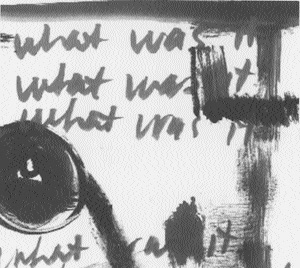
Norie Neumark, A Shock in the Ear
Other works displayed the broader and less literal investigations that need to occur at an advanced level in order to expand the use of multimedia. Shock in the Ear, devised by a small team led by Norie Neumark, places sound into the frame for careful scrutiny as the under-exploited medium amongst the multimedia. Fragments of sounds and sentences are triggered by mouse rollovers, movement across painted images and graphics—the cursor might contain a hand-written word: “how”, “where”, “what”, the word repeated and developed in a cadenza of narrative and related and unrelated sound effects and music. Neumark’s long association with sound works accounts for a maturity in the architecture of her poetry and the way it becomes performance, open to variation and nuance according to the response of the interacting subject. Similarly, the visuals perform in various juxtaposition, though not as lyrically. Instead of the concrete, the visual track relies on the expressionist, using typography and the obfuscation of reprographics. Navigation is complex, causing loops to repeat and leave you wondering whether you had influenced a flow or simply observed a pre-determined change.
Martine Corompt’s The Cute Machine (also exhibited at Cyber Cultures), takes the spherical render into the kind of artificial life areas invented and perpetuated by Disney aesthetics, re-defined and re-distributed by Japanese comics’ obsession with the Euro ‘round-eye’ infant-being, and identified by zoologists as neoteny. (Is that teeny as in tiny?) Well, infantile traits it seems under the Neotenic influence can remain with otherwise fully matured adults and become an aesthetic which Corompt demonstrates as a mutational form. The lurid pinks and sickly greens on the screen and the vinyl ‘skin’ of the installation are suitably unsettling, reminding us of the proximity of bovine to beef, cherubs to nappies, round eyes to famine appeals…cute to lie.
Linear electronic forms in the video lounge did not all have those smoothly rendered surfaces. Sam Landels’ Hydra revisited systems of representation based on persistence of vision, ingeniously adapting video technology to the formal task in hand. Strobing and fragmentation foregrounded the image as object and, with a dynamic relation to the frame, process.
techné demonstrated that artists have reached a critical mass in relation to interactive multimedia, particularly by visiting the web sites that had been bookmarked. The informative catalogue reveals that many of the new and younger artists have been trained straight into multimedia, without bringing the baggage of the Jurassic—this has clearly weakened some whilst liberating others, depending on their points of reference and I suppose, your point of view.
Cyber Cultures
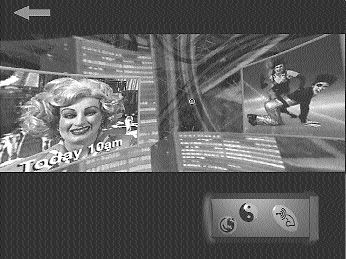
VNS Matrix, BAD CODE
Cyber Cultures was curated by Kathy Cleland and David Cranswick through Street Level, which supports and advocates contemporary art initiatives for artists and audiences in Western Sydney.
The expansive physical framework of the Powerhouse provided draped nooks and crannies for video projector-based interactive installations, and a screenings area. Two seminar days and evenings of performance complemented this rich survey of new media work.
Thematically, the ten interactive installations were concerned “…with issues of human identity and its boundaries…”, in the evolutionary sense. They were also linked financially: nine of the works represented the outcomes of the Australian Film Commission’s investment in artists’ projects; the Australia Council assisted with two.
Troy Innocent’s Untitled, as the title suggests, is in development but advances loudly into the AL (artificial life) area. Innocent moves away from an obsession with shiny and globular entities towards the generation of (loud and shiny) sounds created by the visitor drop-and-dragging globular creatures into a circle projected onto a camera obscura-like table-top. It has something of the feel of an ornamental pond where the fish breed simply to provide the unsettling sounds of industrial mayhem!
The User Unfriendly Interface from Josephine Starrs and Leon Cmielewski assaults the sensibilities of gentle nerds with a lot of impertinence, puns and other slippery slopes designed to remind us in faux troglodyte style that the personal computer is a dubious thing. The customised casing looks ready to rip your eyes out.
Merlin Integrated Media’s interactive CD-ROM, Metabody, documents one of the most interesting collaborations to occur in Australia last year between Stelarc, Merlin and Mic Gruchy, which included an ‘electrifying’ live world wide internet performance at Artspace last April. This interactive is encyclopedic, ranging from Stelarc’s hook suspensions to the direct wiring of the audience. It is the snapshot of a career, but has built in the ability—via an internet connection—to not only update but also extend the means by which the audience may participate.
The long anticipated Bad Code from the VNS Matrix team made a sneak preview, treading “a fine line between artwork and commercial prototype, aiming to inject alternative narratives and characters into a ‘shoot-em-up’ dominated games market”. The All New Gen mob together with the DNA Sluts up against Big Daddy Mainframe (BDM) is the basic scenario that has been rehearsed some time now, and one has to ask in these days of internets and intranets, how has BDM survived as the villain? Whilst ‘the look’ is intriguing, the feel for the game is obscure and it currently remains true to its title.
Invert is somewhat enigmatic. Lloyd Sharp’s “organic artwork” is about organs…and other processes, and parts, and orifices…about various of our physical functions, vectored through the sensibilities of the artist’s own experience of challenged health. It is an interactive partially using the game metaphor but mainly approached using Sharp’s idea of the metaphor of “personality”—which could be another way of saying unpredictable. Hence the enigma. Whilst the piece is life affirmative and has amusing cursor devices that ambush one another on screen, its personality swings between the pedagogic statement and a visceral space of images.
This is quite unlike the clear spaces that are created in another internal journey, Isabelle Delmotte’s Epileptograph. Large high definition images and shattering sound provide internalised glimpses of the experience of epileptic seizures, from which Delmotte suffers. Sequences of these images are shown on small video screens. (The process of making this work has also enabled the artist to reclaim to consciousness parts of the experience which are otherwise entirely erased from her memory.) Finally, a word description of the five stages of a siezure from the artist’s point-of-view. As a totality, we comprehend, through the cognitive process, and at a safe distance.
Both exhibitions had major involvement from the Industry and Cultural Development Branch of the AFC, and a haggle of others. Audiences can now look forward to a period where, in the public spaces, work is prudently selected, where the time required for participation or even interaction with multimedia work is in relation to the kind of concentration that most people can sustain during a single visit. On-line participation, the promised connections permitting, will become like videos and television—subject to the vicissitudes of the audience in response to the matrixes of options. Whilst techné, gave us another glimpse of this future, Cyber Cultures not only celebrated the physically interactive exhibition spaces of Casula but enabled the socialisation of many of the exhibits, a step away from what one arts commentator has helplessly observed as the “diminished aesthetic experience of a video monitor…”
techné, IMAGO, at PICA, Festival of Perth, February 13-March 9
Cyber Cultures, presented by Street Level at the Casula Powerhouse, Casula, Sydney, March 9–April 6, 1997
RealTime issue #18 April-May 1997 pg. 21
© Mike Leggett; for permission to reproduce apply to realtime@realtimearts.net
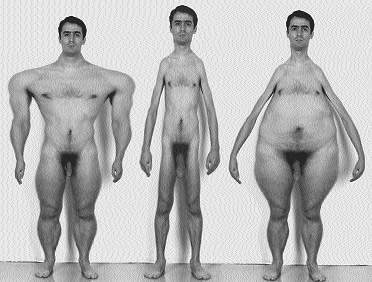
John Tonkin, Elastic Masculinities
Using his body as a template, Sydney-based new media artist John Tonkin has created a corpus of static faces and morphing bodies which the viewer/user is invited to adjust, tweak and—ultimately—pass judgment upon.
Tonkin developed an interest in pseudo-sciences relating specifically to the body after viewing an exhibition of physiognomic drawings and artefacts in 1992. He was particularly interested in how such theories could interplay with emergent morphing technologies.
Elective Physiognomies and Elastic Masculinities are the outcomes of Tonkin’s exploration into ideas relating to the face and body as sites of identity, in particular, identity which can be culturally mapped through the employment of ‘scientific’ modalities. Both works were recently shown at The Performance Space and at the Cyber Cultures exhibition at the Casula Powerhouse.
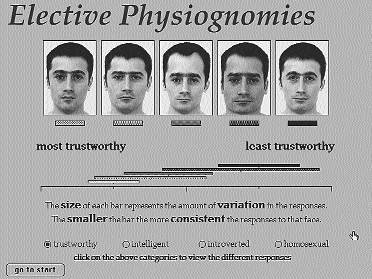
John Tonkin, Elective Physiognomies
Elective Physiognomies comprises an interactive, authored in Hypercard, and a series of printouts of digitally manipulated faces and fictional DNA code. The interactive invites the user to prioritise a number of these faces (which use the artist’s face as starting point, or source code if you like) according to criteria including most-to-least trustworthy, most-to-least intelligent, most-to-least homosexual. The interactive then tabulates the user’s response against the combined average of all previous user responses to ascertain the consistency of response to each face.
For Tonkin, this statistical component, while interesting, is not as important as the creation of an interactive structure which, through the user’s navigation, gives rise to the ideas and themes of the piece. In this manner the task structure of Elective Physiognomies insists upon the disturbing outcome of codifying faciality to such levels of rigidity and generalisation.
Tonkin takes this notion further in his most recent work, Elastic Masculinities. Here, the artist uses his full body as a point of departure to question the perceived alignment of masculine attributes with particular body shapes. Similar to Elective Physiognomies, the piece comprises a series of printouts of fictional bodies alongside a Java-authored interactive. The user is invited to adjust the dimensions (height, chest, hips, etc) of a randomly generated body and is then asked to classify the constructed body according to sliding criteria which includes gentle/forceful, graceful/awkward, masculine/feminine.
Elastic Masculinities is currently at beta stage; future versions of the work are intended to provide the user with an image of the statistically average body (again using tabulations of previous user responses) for each chosen position along the sliding criteria. In doing so, Tonkin hopes to prompt the user to question the validity of systematisation in such diffuse areas as gender and subjectivity.
The next piece in Tonkin’s evolving body of work will investigate eugenics and genetic modelling as they relate to morphing technologies. Currently in development, the work stems from the artist’s response to a perception that biological metaphors and allied evolutionary navigational systems are on the increase.
For further reference, the 1996 Ars Electronica network symposium—Memesis: The Future of Evolution—is particularly useful: www.aec.at/meme/symp [expired].
John Tonkin, Cyber Cultures, Casula Powerhouse, March 9-April 6
RealTime issue #18 April-May 1997 pg. 23
© Vicki Sowry; for permission to reproduce apply to realtime@realtimearts.net
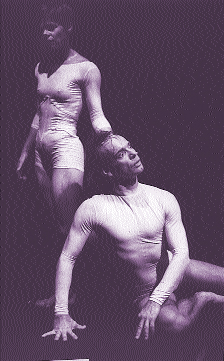
Margrete Helgeby and Stefan Karlsson in I am Nijinsky
photo Ashley de Prazer
Margrete Helgeby and Stefan Karlsson in I am Nijinsky
I am confused about the space I am in. Several weeks ago this room was much smaller. I’ve never known the PICA performance space to extend so far (seemingly to infinity), but stretch away it does and its angle and the images projecting onto the division add to my confusion. In I Am Nijinsky Stefan Karlsson is Nijinsky, sometimes. I’m sure that this space was smaller when I watched ID339 move around The Living Room they created back in November.
Can this be the same space? On that occasion there were corrugated cardboard walls as obviously flimsy as the facades of so many human relationships. This dancing trio’s fragile relational world orbits around their (and our) omnipresent host, David Hobbs. He spins discs, plugs and unplugs lights, moves and removes furniture. I expect him to give us the Terry Jones grin at any moment, but no Pythonesque cliches here.
The angled wall in front of me is hinged and I am witnessing a new episode in Nijinsky’s life opening, with the space, to reveal an oblong (one that Vaslav’s obtuse creativity may not fit into)—all around is monochrome. He dances or Stefan Karlsson does. His partner is Margrete Helgeby. I’ve seen her dance before. It is her. But only Karlsson confirms his identity. Then subverts it. They dance in real space as some other dance overlays their presence. (How did they do that?) These are phantoms I’m seeing—a virtual Karlsson and Helgeby—spirits of themselves floating impossibly away from real time.
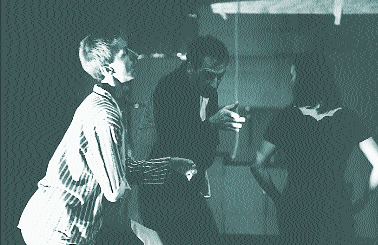
Paul Johnson, Bill Handley and Paige Gordon in ID339’s The Living Room
photo Performance Photography
Paul Johnson, Bill Handley and Paige Gordon in ID339’s The Living Room
There was none of this virtuality with The Living Room. I knew where I was! Bill Handley’s foot-tapping, Paige Gordon’s obsession with the marking out of the floor, feet on the ground! I know this hop-scotch cum Olympic pool game, it’s familiar. When the mediocrity becomes too much, oppress or compete. Handley restrains Gordon. She thinks she is free he pulls her back again. Why? Hobbs organises some music, something from the modern jazz catalogue on a monaural gramophone just like my Dad had in the 60s. He needs to change the lights—he tugs on the double adaptor. This show is so low tech it’s nerve-racking. Paul Johnson starts a card game. I’m feeling the claustrophobia now, the cardboard walls have been erected to stand one third of the way into the space. I want to cut my way through them, get away from the interminable swish of the ceiling fans, the looks that pass between the performers and the conversations that go nowhere.
Now Nijinsky begins to collapse. His various mentors and ‘friends’ (Boris Radmilovich and Claire Jones) discuss his dilemma as Karlsson contextualises the historical Nijinsky within his own 1990s symbolism. What did this man mean to dancers? What does the Nijinsky canon represent? I’m feeling closed in again but this is the crowd around me causing my discomfort, tonight is a sell-out.
As I leave I wonder about the theatre of Sally Richardson moving toward dance and the dance of Paul Gazzola’s ID339 moving toward theatre. It’s an important shifting of ground. I suspect that the two genres cannot continue to be successful without amalgamation. The design conduits provided by the expertise of such people as Gary Chard and Graeme MacLeod may provide the route along which these journeys will travel.
The Living Room, ID339, PICA, November 26-December 1, 1996
I Am Nijinsky, written by Sally Richardson, produced by Deckchair Theatre and Sally Richardson, Perth Institute of Contemporary Art, January 8-February 1, 1997.
RealTime issue #18 April-May 1997 pg. 36
© Tony Osborne; for permission to reproduce apply to realtime@realtimearts.net
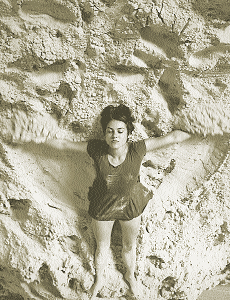
Evelyn Switajewski in To Run—Sand (rehearsal)
photo Brad Hick
Evelyn Switajewski in To Run—Sand (rehearsal)
“Direct images of matter. Vision names them, but the hand knows them. A dynamic joy touches them, kneads them, makes them lighter. One dreams these images of matter substantially, intimately, rejecting forms—perishable forms—and vain images, the becoming of surfaces. They have weight, they are a heart.”
Gaston Bachelard
In a cavernous iron warehouse at the back of the old Brunswick brickworks, behind the vertiginous chimneys of the kilns and the blackened skeletons of derelict machinery, an island of moist white sand floats in a sea of powdery grey brickdust and rubble. Prefiguring its future performance space in the city, the rehearsal space for To Run—Sand has been installed in the bowels of an abandoned industrial workplace—a site still palpably ghosted by its former function, and by those that worked and sweated and dreamed there. The only sounds now are the muffled wingbeats and cucurucus of pigeons far overhead. Until the digging starts.
Every session begins with digging. The island of sand, both setting and generative source for this dance-theatre performance, is on the move again. The impact of footfalls and bodies disperses the sand, it flows outwards, a slo-mo crystalline liquid. We rebuild two mounds, one as conical as a Hokusai Fuji, the other slightly flattened, volcanic. Our digging is punctuated with jokes about (im)possible careers with Vicroads. The remaining sand is raked, and the rehearsal begins.
Heraclitus suggested that one could never bathe in the same river twice; similarly, every time the performers return to the sand its reality shifts, literally and metaphorically. It possesses the pulsional mutability and discontinuity Gaston Bachelard called “intimate immensity”. At moments it suggests a pocket of coastal dune or beach, a lovers’ retreat, a children’s playground, or an island of enchantment and imprisonment, like Prospero’s; at others, it becomes battlefield, labour camp, post-industrial wasteland, mountain range, moonscape—or desert, that core postmodern metaphor for the nomadic and the dis/appearing. And it is the fluidity of the sand’s topographic referentiality that allows the performers (and those watching them) a remarkable associational freedom in narratives enacted and images inhabited.
Material is generated primarily through games, tasks, structured improvisations and free play; once Alison has set up an activity, she rarely intervenes. Images cluster around primordial transformations of status in the flux of inter-relations: playing, working, running, fighting, falling, burying, birthing. The three performers are developing quite different relationships with the sand, each one contradictory and polyvalent. And it is the materiality of these relationships that generates narratives, images and ‘characters’. Today Evelyn’s actions suggest elegant entrapment, a kind of perky buoyancy against all the odds, like Winnie in Beckett’s Happy Days. Adrian is both ever playful and consumed by reverie, encumbered by the gravity of possibility; with the smile of Sisyphus, he moulds his desires and memories in the sand. Yumi is explosive, she leaps and digs with an energy that irradiates far beyond the outer edge of the sand—but her contact with it is consistently light, she touches and brushes with quiet patience and focus.
In many ways, the group’s recognition of the sand’s active role as trigger and co-performer celebrates Bachelard’s “material imagination”, which, “going beyond the attractions of the imagination of forms, thinks matter, dreams in it, lives in it, or, in other words, materialises the imaginary”. In Bachelard’s phenomenological poetics of the elements, matter (“the unconscious of form”, the “mother-substance” of dreams) reverberates to become “the mirror of our energy”, producing images “incapable of repose”.
In rehearsal the sand becomes a register of the actions and emotions that it has elicited from the performers; it mirrors their energy. Intimate, substantial afterimages of what was are retained within what is, although these trace impressions of the contours and gravities of presences-now-absent are always temporary, fleeting. Like memories, like identities, the marks in the sand are continuously overwritten or partially erased. But in the materiality of the instant, for those that work and sweat and dream there, they have weight, they are a heart.
To Run—Sand by Alison Halit, performed by Adrian Nunes, Evelyn Switajewski and Yumi Umiumare at the Economiser Building, Spencer Street Power Station, Melbourne, April 8-20, April 22-27, April 30-May 4
RealTime issue #18 April-May 1997 pg. 33
© David Williams (Melb); for permission to reproduce apply to realtime@realtimearts.net
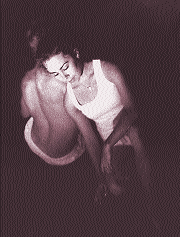
Sara Brown and Shannon Anderson in Intimate Letters
photo Eve Wicks
Sara Brown and Shannon Anderson in Intimate Letters
We arrive at the performance on a busy street at night. Brian Lucas is sitting opposite us at a small table, writing. Cars obscure our vision. Candles, a table, earnest writing, lots of smoking. This is Brisbane’s industrial area. His presence nearly causes an accident. Milling about on the street opposite we are handed a program folded like an old letter. Inside are instructions and guides to letter writing from Routledge’s Complete Letter Writer for Ladies and Gentlemen. Looking across three lanes of traffic, Brian is still smoking and writing.
Intimate Letters entices and suggests. All the works are short—small windows into other people’s lives. Are we to be voyeurs of their intimacy? Letters are the starting point for this show, curated by Shaaron Boughen.
We are ushered up a narrow staircase and find ourselves in a small first floor warehouse. Incense hangs heavily. Murkiness cloaks the space. We are in someone else’s room. A shaft of light struggles through the pungent smell and settles on a crumpled letter that has been dropped on the floor. Electric shadows project on the wall in front of us what we have just witnessed live on the street below: Brian writing. The heavy Gorecki music adds to this overwhelming atmosphere. This show is a constant play with shadows and light, with reality and recollection.
Brian Lucas begins by forcing us into watching vulnerability, exposure. His enormous frame is surreal in such a small space. There is too much of him, but his nudity is neither vulnerable nor small. Crouching on a shelf, he unfolds himself to step onto the floor, chanting the words from a child’s game, “I wrote a letter…” He moves forward in the corridor of light, slowly singing, “…and then I must have dropped it”. Slowly moving toward the rectangle of light he stumbles upon the letter he dropped. The piece is clever and simple. The dancer consumes your attention whenever he is on stage. He mixes intensity and humour into the same piece and makes it work. He leaves the stage with a bittersweet joke.
John Utans’ piece begins with projected images of a young couple. The back of her neck, him laughing. Sleeping. The two of them lying together. We are forced to choose between the images and the shadows of dancers. The two performers slowly move from behind the screen in the middle of the stage. They are young, both wearing white underwear. The movement is tentative, slow. Shadows and reality. She is restrained. He is fluid. The duet progresses in tempo. The sinewy movement becomes familiar. Their inexperience is endearing. They show us the gestures of lovers. New lovers. Sitting together. Sleeping. The choreography reveals innocence and captures naivety. New emotions. I am shockingly reminded of the morning hours spent with a lover.
Scotia Monkevitch has created a work from a letter written to the unborn child of a friend. It is a personal issue: a ritual of sorts. It is a prayer for the safe journey of a child. The space is beautifully set behind a gauze screen, but as a performance work, none of the intention is clear. Slow movement and repetitive text. I give you back your word. A phrase endlessly repeated. This work is reliant on the merging of movement, text and design but results in none of these elements working well together. The detached music and repeated words alienate, clouding the original intention, making it difficult to enter the world of the performer.
In the corner of the room a cage is revealed. In Gail Hewton’s piece a woman performs simple gestural movements around its periphery. The cage is restricting and menacing. Is it her mind? Society? A relationship? Or all of them? She breaks out of the cage only to crawl back into it again. Defeated, she slowly unfolds a plastic barrier to surround the cage. Janacek’s music has clearly been imposed on this work, incongruous with the building of tension, detracting from the woman’s emotional journey. The final image is the strongest: the woman is naked, revealed, isolated and captured in the centre of the now opaque cage. A defeating but beautiful image.
Shaaron Boughen’s work retains obvious links to the original inspiration: letters written in 1928 to her stepmother from a boyfriend the family was unaware of. The work begins with a man and a woman sitting on separate piano stools in front of projected images. The images are of the same couple on a stool together. The couple in the film begin a duet of intimacy, trust, weight, beauty, punctuated by flashes of black. Moving carefully. The couple in the film have a private life. The couple in front of us do not move until the film ends. Their duet is dislocated, as if they have just missed each other. They are in the same space and yet are unable to interact. The couple do not touch throughout the live duet. This work is simple in construction but effective, and the film highlights the performers’ strengths. The boy leaves the room and the girl slowly walks down the external stairway. The piece ends with a projected image of the girl walking across the road below us to sit at the table where Brian Lucas was originally writing.
Moving away from conventional modern dance, these choreographers have made work that takes the audience on an emotional journey and it is refreshing to see dance that is looking to be more than vaudeville. Shaaron Boughen has curated a show that feels like one work with many journeys within it. She has made musical choices that mostly work and Matt Scot consistently created magical lighting. Without funding or the time to research and rehearse adequately, independent artists often have to show work that is two dimensional. This show had a fantastic sense of continuity, of unity, but more time to reveal another layer would add to some of the works presented.
Intimate Letters, Choreographers Brian Lucas, John Utans, Scotia Monkivitch, Gail Hewton, Shaaron Boughen. Curated by Shaaron Boughen. The Cherry Herring, March 12-16
RealTime issue #18 April-May 1997 pg. 33
© Clare Dyson; for permission to reproduce apply to realtime@realtimearts.net
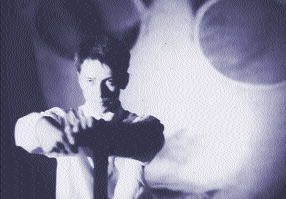
John McCormick, Company in Space’s The Pool is Damned
Early aspirations of Company in Space for this venture included not only simultaneous interactive transmission to Sydney, Perth and Brisbane of The Pool is Dammed: Trial by Video—staged live this month in Banana Alley Vault 10, Flinders Street, Melbourne—but also the performers working from each of these scattered places. Using time variations between cities, there might have been a kind of piggy-backing of performers flying around the country, simultaneously creating a nationwide net of live activity and simulacra. Logistically a nightmare, of course, but if big ideas don’t always come off, the effort to realise them can produce brilliance.
The permutations of Pauline Hanson’s maiden speech shaping national consciousness have become the stuff performers dream of, rendering visible the issues of belief and truth and how they operate within the media’s shifting parameters. I anticipated something special, as I sat ready to watch the Sydney performance, waving briefly to Lucy Guerin as she put her lipstick on in Melbourne. The performance began there, for me, without any sense of a division of boundaries, because I had anticipated that somehow ‘interactive’ augured a different kind of involvement.
Two screens: one vertical and one across the floor which was strewn with sand. The sandpit attracted any child within crawling distance. A video camera on the ceiling squashed children and other patrons’ wandering images flat against the vertical screen, somewhat scrambled and delayed. The vertical screen menu directed that movement across the sand would activate sound events in Melbourne, and you could also acquire other information, such as titles and participants’ names.
Mentally picking my way through the technology, I caught on that the work was divided into sections: Speech (a solo by Trevor Patrick), Dissent (Hellen Sky), Translation (John McCormick), Diplomacy (duet, John McCormick and Trevor Patrick) and Trial (Lucy Guerin). Each dancer had originally developed a kind of character using their own gestural vocabulary, and this gesture was then treated and transformed into the images we saw. The sound collage was a portentously shredded and rebuilt version of Pauline Hanson’s maiden parliamentary speech, also partly manipulated by the audience at selected moments of interaction. But Andrew Morrish’s character of the Orator provided a mostly untreated voice-over explanation of events.
EB Sue-ellen, you saw the original live Melbourne performance as well as the Sydney transmission. How do they compare?
SEK Rather than in those rough-hewn vaults in the Economiser Building, the video performance was staged in an old tunnel underneath Flinders Street Station. It really seemed to make the ideas clearer, having the bodies positioned there with the technology. The impact was so much richer, and the issues seemed much closer, more felt. The highlights for me were definitely Trevor Patrick and Lucy Guerin’s solos. But you missed so much of what Trevor was doing when you only saw the video. I couldn’t even get a sense of it.
EB Yes, that ominous pointing, like some angel of death, it seemed so epic, but you weren’t quite sure why. I guess the subtitle is apt, Gesture, Race and Culture on Trial. What people make of gesture, although it may not be related to the truth, becomes the truth.
SEK Well, you understood why in the live performance. The live bodies spoke so much more eloquently than the technology alone. Especially during Trevor’s solo, you could hear words from Pauline Hanson’s speech, not the actual speech, but a distorted version. He stood on a pedestal. Above and in front was his huge, silver glowing distorted image. But you also saw Trevor, the person, a live, normal, cool body, and you realised just how unlike him the distortion was, even though people might still say that’s him. And not just the performers, but the subject matter itself is totally mediated by the technology. When you see both together, there’s the possibility of a different level of understanding.
EB Believing what you see and hear. I loved the oration, Andrew Morrish talking about teflon suits, persuasive speakers, how we need to believe: “I believed everything that was written…I believed that Spot could run”. Our capacity to learn and understand language and gesture depends on a capacity to believe that what we hear and see is true.
SEK In Trevor’s dance, with his live presence, the video screen, and the distorted sound, you get confused as to where the authority is coming from. Then you see it’s about manipulation, all those Hitlerish gestures. Manipulation by the media, and by politicians. There seemed no freedom, no freedom of speech.
EB I found the interactivity disappointing. I think it was more fun for the technicians running around and setting it up. In the end there wasn’t much to do. I was all prepared to get up there and jump around, but all you could do was play with the sound. I was hoping for a different kind of interactivity, enough so maybe you could talk to dancers while they were actually performing. One’s imagination sets impossible tasks.
What was Hellen Sky doing in the section called Dissent? It was hard to know what sections were about if you didn’t read the program. I remember she was wearing pearls, and I remembered Pauline Hanson’s photograph. And once again, those epic gestures had to mean something, but what?
SEK I didn’t really get a sense of what the performers were doing through the video, but I remember that sense of distortion. For instance, with the sound, all those words from Hanson’s speech, some like ‘multicultural’ stood out. They took on a new kind of currency.
EB The distortion and complexity becomes the point, doesn’t it? I don’t think most people know what was actually in Pauline Hanson’s speech, or what she meant by it. But there’s been so much talk, everyone thinks they do know (Frontline recently demonstrated that really well). People interpret speech and gesture in ways that make them happiest.
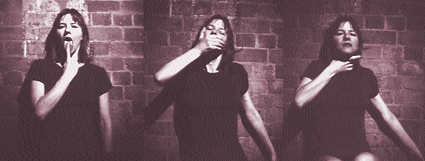
Lucy Guerin, Company in Space’s The Pool is Damned
SEK And Lucy’s solo, in the Melbourne version, was emotionally so strong. She made me feel that the effort to communicate, with those anguished gestures, seemed doomed to fail. We were all on trial.
EB In the video, it was hard to see what she was actually doing. I guess that’s the point too. Like Chinese whispers, you remember the clearest gestures best—like the slash across the throat, the red dress. That’s a distortion of the message. People had to sweep the sand from the screen to see her.
And maybe the fact that it’s A Trial by Video means that we miss a lot of the detail of what’s really going on. When witnesses speak via video in court, it’s because they are fragile or vulnerable for some reason, like young children. It’s easier for a child to cope in a court when they don’t have to experience all the frightening detail of the flesh. At the same time, that’s a distortion of the real message, without all its emotional nuances. News clips about current events are generally all the information people get. You know it’s tampered with, and yet you have no option but to accept it as genuine information, at some level.
And what about the body in Garry Stewart’s Helmet?
SEK It wasn’t a brilliant piece, but it was more than ‘arm and leg dancing’, to coin a phrase. I think it made sense in the context of Foucault, the medicalisation of the western body—showing freaks, bodies pushed to extremes, and our cultural obsession with that. In the context of all those elements, the way it was designed, the mixed media, the costumes, I could enjoy watching the movement, and for once, dance that’s extreme, hard and fast and pushing bodies to a level that ordinary bodies never even dream about, it actually made sense.
EB I wondered how purposeful Garry was in using that western modern ballet material, and those extreme physical states the dancers needed to go to, to perform his particular choreography. Justifying that by using yoga to demonstrate just another kind of ‘freakish’ physical state one can aspire to, seemed thin to me. I don’t feel he took the philosophical implications of any of that material into account.
SEK I think he made a real effort to stand outside the language, to comment on our culture’s need for those extremes, pushing the excitement boundaries, and I like that, but I suspect that he really does love the physicality more than the discussion of it, even though he couches his desires in that questioning kind of way. I could appreciate Craig Proctor’s yoga demonstration (I hate it when yoga is called ‘contortions’), but it bothered me slightly that the context Garry offered gave it no meaning other than contortion, extremity and abuse.
But I don’t know whether he had complete control over everything. When you’re about to perform, a lot of things happen that you’re not really author of. So, maybe it was a happy mixture of many people’s input.
EB Perhaps it was accidentally interesting?
SEK It doesn’t matter whether it’s accidental or not. The issues raised are worth thinking about.
–
The Pool is Dammed: A Trial by Video—Gesture, Race and Culture on Trial, Company in Space. Conceived by John McCormick; score, Garth Paine; lighting, Greg Dyson; cameras/photography, Gary Sheperd, Oliver Uan Qiu Wang; computer graphics:, Luban White. On-line from Melbourne to PICA, Perth; Experimetro, Brisbane; and The Performance Space, Sydney, March 4-15
Helmet, choreography by Garry Stewart, designed by Brett Chamberlain, Daniel Tobin, The Performance Space, February 3-14 1997
RealTime issue #18 April-May 1997 pg. 35
© Eleanor Brickhill; for permission to reproduce apply to realtime@realtimearts.net
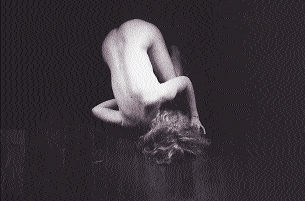
Alice Cummins, falling from grace
photo Suzi Wild
Alice Cummins, falling from grace
Falling from grace—It is the place she dances from which is so astonishing—a place where decades of maturing consciousness, of lived and stored experience, are all wiped clear. Her feet have never touched the ground. She has never cried or smiled. There is nothing, no one else, but her. Yet all through the piece voices speak. Their recorded discourse is a familiar one of donors and surrogates, implanting and freezing, of hungering and dying for a baby. It is the kind of talk in which sometimes I engage. But not now. Now, I am absorbed by the dance and the words serve as markers of how far away that talk is.
moebius loop—Atomic tests and ballet exams…Camelot, moratorium marches, The Australian Ballet at His Majesty’s…an arts grant, No Sugar, protests at the brewery…The words themselves suggest connections, and Alice, as she speaks them, colours and redraws the links from memories in her bones and skin and organs. 1950…1965…1970 …1990. Behind the tumbling mix and match—and sometimes over it—a slower, stranger history is projected. We see close-ups of a giant, watching eye; a nipple puckered like a sunflower; wet and hairy flesh-folds that are only possibly an armpit.
lullaby—I remember the asymmetries, a dance of intimate, ungainly beauty: Alice folded over from the hips, one arm stretched downwards, the hand turned in and resting on the floor; Alice on her back, limbs raised to plough the air; stretches which luxuriate like yawns; explorations of the kind which dreams pursue, curling back upon the past without object or intent in view. Within the confines of a spotlit island, within the boundaries of her skin, Alice is tracing threads to the unknown.
Broadcast Dancing: Three new works by Alice Cummins, Perth Institute of Contemporary Art, December 4-8, 1996
RealTime issue #18 April-May 1997 pg. 36
© Fiona Mclean; for permission to reproduce apply to realtime@realtimearts.net
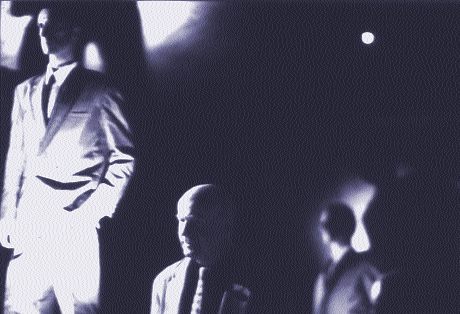
Trevor Patrick, Andrew Morrish, Company in Space’s The Pool is Damned
Performances utilising new technologies or an ‘interactive’ media environment are like waiting for Godot. The Pool is Damned opened with an explanation of the set-up—the cameras, the computer system and crew connecting us to Perth—but because it was five o’clock in the afternoon our solo audience at Perth Institute for Contemporary Art was the technician, who duly sent us a cheerio wave. And at midnight in Melbourne, when the audience in Perth were comfortable, the dancers had been performing in the vault for a handful of friends. The potential of this project is to merge dance with video via teleconferencing through which audiences can share a focus or trigger special effects that might also change the dance.
In spite of this virtual possibility, I was pleased to have seen the first incarnation of this piece as Part 1 when it was presented in the haunting brick shell of the ‘economiser building’, Melbourne’s first power station. Nineteenth century dirt floors and mortared walls provided a context that contrasted sharply with the digitised programming system projected on large video screens. Here, the itinerant audience encountered the dancers in suddenly illuminated lightwells, sometimes glimpsing their frantic signals better in the distortions than in the darkness. There was also an urgency about it, compounded by its immediate address to the race debate then at fever pitch in the mass media.
For almost 15 minutes the sound-modified text of Pauline Hanson’s maiden parliamentary speech filled the air whilst dancer Trevor Patrick slowly outlined the rhetorical style of rage—his images on a large screen becoming vitriolic, red, blue; or baboon-like in an x-ray vision of hollow cheek and bared teeth; and a silver foil effect turned him into a robotic magnification of power.
A series of cameo performances each worked with gestural vocabularies to frame modes of contemporary social hysteria. Hellen Sky’s crippled posturing of the socialite, the embrace of charity and pity—the crossed fingers, the licking of thumbs, the nervousness of smoking and the ineffective peace sign suddenly becoming the pointed gun. Memorable was Lucy Guerin dressed in Barbie pink shirt and red plastic mini with her mop of hair rolling and vibrating between two poles against a sky blue background. Her frantic washing of hands—to get rid of stains—replaced by a clutching and pecking. Pressed against the wall, she counts desperately—two fingers to lips, one in mouth, one zips lips shut, five cover mouth, 10 curl up into a ball.
And a duet of corporate masculinity between John McCormick and Trevor Patrick made you ignore the screens and become interested in these two slight and suited men holding each other up, pushing, clutching, hugging and then saluting. The Caucasian and the Asian in the embrace of patriarchal capitalism. The complexity of the issues at stake—the rhetorical vocabularies of racism and their manipulation of the public—seem to have been eroded in Part 2. Presented in more intimate, more pristine circumstances the ‘virtual trial’ overtook the performed event. To counteract audience confusion, there was now an actor, who set out to normalise the technology and simplify the objects and structures of racism. He tells us, too directly, about “the polite-ician; poli-technician who thinks that in their fish and chip shop they have the truth”.
But unexamined were the silent technologies of power enacted in the spaces between performance and video. Clever technology can both disintegrate and construct the power of the speaker but it cannot replace the subject-dancer’s capacity to reveal the gaps between real and imagined effects. When a train passed overhead, in this brick bunker underneath the city, the rumbling was louder than the computerised sound and the walls trembled against my back. My fear then was of being trapped in a world where audiences were compelled to watch mediated images whilst all around the bricks fell.
RealTime issue #18 April-May 1997 pg. 34
© Rachel Fensham; for permission to reproduce apply to realtime@realtimearts.net
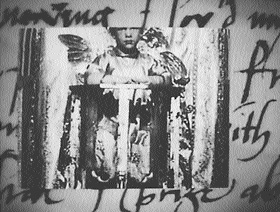 Sydney Intermedia Network (SIN) will present its seventh annual survey of Australian screen art at the Art Gallery of New South Wales, April 5-12. In addition to the regular film and video component, this year’s Matinaze will also include a multimedia exhibition of interactive CD-ROMs and a forum/presentation by three highly acclaimed new media artists.
Sydney Intermedia Network (SIN) will present its seventh annual survey of Australian screen art at the Art Gallery of New South Wales, April 5-12. In addition to the regular film and video component, this year’s Matinaze will also include a multimedia exhibition of interactive CD-ROMs and a forum/presentation by three highly acclaimed new media artists.
SIN, formerly the Sydney Super 8 Film Group, has been promoting the innovative use of film, video and new media since 1990. Matinaze, a major showcase for experimental film and video, has continued in the tradition of the earlier organisation’s hugely popular annual Super 8 film festivals which began in 1980.
The film and video program (screening Saturday April 5, repeated Saturday April 12) now comprises work produced on a variety of formats including U-Matic, SP Betacam, 16mm, and computer animation. Highlights include John Tonkin’s man ascending, Merilyn Fairskye’s Plane Torque, Paul Winkler’s controversial Time Out for Sport, and Miriam Stirling’s take on Peter Greenaway, titled Wednesday, 11th May, at 1pm.
SIN’s newly appointed director, Alessio Cavallaro, is especially pleased that Matinaze ’97 will provide the Australian premieres of CD-ROMs by Megan Heyward and Sally Pryor, and the Sydney premiere of Norie Neumark’s interactive. “These are impressive works, and particularly interesting in that sound design is a major element in each of the productions”, said Cavallaro.
The three artists will demonstrate and discuss aesthetic and technical aspects of their work at a forum on Sunday April 6. Heyward’s I am a Singer explores notions of memory, culture and identity. The interactive’s user assists a pop star with amnesia to reconstruct her identity through media reports, diaries, anecdote and dream. Pryor’s Postcard from Tunis, a rich audiovisual collage that reflects the artist’s impressions of Tunisian culture, is essentially about inscriptions: ancient and contemporary Tunisian scripts and drawings as inscribed through the computer interface. Both CD-ROMs were featured in the New Talent Pavilion at Milia, the major European multimedia exhibition held in Cannes earlier this year. Neumark’s Shock in the Ear is a sound-centred interactive of “shock aesthetics” which describes deep and abrupt physical, psychic and cultural change. The gallery installation version of Shock in the Ear, with multiple computer screens and “sense sites”, will open at Artspace, Sydney, on April 17.
A week-long interactive multimedia exhibition in the foyer area of the AGNSW’s Domain Theatre will include recent works by Bronwyn Coupe, Ross Franks, Janet Merewether and Lloyd Sharp, as well as Neumark’s and Pryor’s CD-ROMs.
Events such as Matinaze are vital for the continuation of a vigorous screen culture. Internationally renowned Australian video artist Peter Callas—who was on the event’s selection panel with interdisciplinary media artist Nola Farman and screen culture commentator Annemarie Jonson—noted that “it’s very important to have survey exhibitions like Matinaze on a regular basis…to see what other people are making in a non-competitive context”. Alessio Cavallaro explained that Matinaze, like other SIN activities, is about cultivating the talent and profile of both emerging and established independent screen practitioners, and developing broader audiences for their work nationally and internationally. He emphasised that these and other activities by related screen culture organisations will be severely affected if certain funding recommendations contained in the Gonski Report are adopted. Celebrate innovative Australian screen art at Matinaze ’97-’98 might be too late.
Sydney Intermedia Network’s Matinaze ’97, April 5-12, Domain Theatre, level 1, Art Gallery of New South Wales, Sydney.
RealTime issue #18 April-May 1997 pg. 25
© RealTime ; for permission to reproduce apply to realtime@realtimearts.net
From humble beginnings, brainstorming in West End cafes 18 months ago, the Queensland Multimedia Arts Centre (QMAC) has grown from a core of seven to nearly 200 members, creating a strong support network for Queensland’s fast-growing art and technology community.
The success of projects such as the Multimedia Arts Forum at which 150 people braved thunderstorms last April to attend workshops and lectures and Byte the Big One, a series of workshops and concerts broadcast live to TV and the internet in November has helped solidify QMAC’s role in serving artists.
In May and June of this year as part of the Brisbane Fringe Festival, QMAC will present eMedia, a festival of Brisbane’s emerging and electronic arts with a hefty program of exhibitions, film showings, seminars, workshops and performance art. The festival is designed to enhance the emerging arts and technology industries in Queensland by assisting artists in creative development and distribution while also showing businesses multimedia market potentials.
eMedia will inhabit various sites around Brisbane, the major event set for the Grand Orbit on Sunday, June 8. Overload will inundate the senses with exhilarating artwork and fast-paced, techno rhythms. Satellite link-ups will beam participants into New York for interactive seminars from some of the city’s new media artists; experts around the world to discuss technical, commercial, creative and philosophical developments in multimedia. Overload will also launch three of Queensland’s most exciting art websites: the Queensland Museum, Brisbane City Council’s Suburban Stories and Artscape.
Elsewhere during eMedia the Griller Girls will take over H Block Gallery at QUT with a multimedia exhibition spinning off from New York art terrorists Guerilla Girls. The festival will also host the Queensland premiere of Mic Gruchy’s new documentary, Stelarc/Psycho/Cyber. As a development project, QUT Communications Design students will create an eMedia commercial to be aired on Channel 7.
QMAC president, Scot Thrane says “eMedia is designed to provide a structure for artists to create, develop, produce, exhibit and distribute their work. Queensland doesn’t have a central multimedia core. There are many different groups and they all do their respective bits but they’re not all interconnected yet. This festival has been initiated so that the artists can have a place to create work and distribute their art. Queenslanders haven’t realised the potential of their content yet. We’ve got things happening here that aren’t happening anywhere else. Equipment like QANTM’s Silicon Graphics studio—there are only three of those in the world and one of them is in Queensland. eMedia is providing a pathway for artists with no computer experience to be able to work on any level of technology they choose”.
According to electronic artist Paul Brown, Brisbane resident for two years, “I think there’s a far more egalitarian art scene here than in southern centres. It has helped a lot of arts communities. John Tonkin came up here on a residency a couple of years ago and he was quite amazed at the number of mature-age students embracing new media technologies. It was clearly part of an encouraging Brisbane culture”.
Brown is concerned about the so-called brain drain of Australian artists shifting overseas and Queensland artists taking their talent south and hopes that eMedia will help stimulate the state’s industry. “eMedia and QUT’s Communications Design course and other initiatives will make it attractive for artists to stay in Australia. Being exposed to what’s being produced is very important for an emerging art, which is why eMedia is important for students. When you’ve only seen a small amount of work with a new medium it’s very hard to know where to push the limits and where the potential is. It is a fundamental relationship between the Arts and Industry which makes up the foundation of the eMedia philosophy. Neither can survive without the other and when united they form a powerful cultural force. It is hoped that the energy created by this union will provide Brisbane with a showcase of what’s really happening in the nether regions of our mother boards.”
eMedia Brisbane, May 23-June 9.
RealTime issue #18 April-May 1997 pg. 25
© Mary Gilliver; for permission to reproduce apply to realtime@realtimearts.net
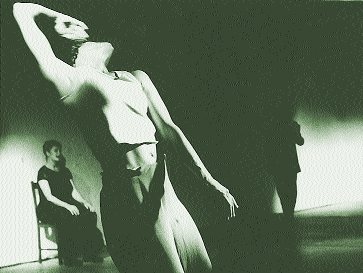
Six variations on a lie, Ros Crisp
photo Heidrun Löhr
Six variations on a lie, Ros Crisp
The challenge of writing about dance was one of the topics for The Performance Space’s anti-static forum (the whole event will be reported in RealTime 19) at the Art Gallery of New South Wales. I don’t write about dance, but sometimes I feel compelled to, just as Virginia Baxter did in RealTime 17, reading Molissa Fenley’s Sydney Festival performance from another angle, the face). Seeing American Jennifer Monson’s remarkable contribution to anti-static, with its absolute shifts from nuance to explosion, from interiority to consuming gaze, from the mundanely material to the spiritual, made me re-think/re-experience Rosalind Crisp’s Six Variations On A Lie (Omeo Dance Studio, March 7-9). Six Variations…is a diminuendo, from physical explosion to stillness and silence, a vast and exhausting release, the dancer’s bursts of energy recurring less frequently, more slowly (revealing their choreographic and especially gestural shape). Against and eventually into this pattern, Ion Pearce plays a delicate cello composition while a very pregnant Nikki Heywood sits still, watching, muttering a barely intelligible mothering ‘are you okay?/pull yourself together’ type tongue. A third accompaniment is a sole male figure climbing down a ladder and crossing the performance area with a parcel towards an unspecified destination at slowest Butoh pace. While this variation seemed too familiar, the Pearce and Heywood presences were rich in the evocation of a dialogue between pent up physical force and the ambiguities of advice and consolation. In Rosalind Crisp’s work the meaning and source of emotion is not always clear, and for some that’s distancing. But she is one of Sydney’s most indiosyncratic self-choreographing dancers, and, for me Six Variations…got closer to the release of an essence.
–
RealTime issue #18 April-May 1997 pg. 36
© Keith Gallasch; for permission to reproduce apply to realtime@realtimearts.net
The performers are at the centre of the work, co-creators of the performance, each moving from their own historical centre, revealing an individual kinesthetic experience of the space. The work is not about demonstrating virtuosity or even thinking about what the movement ‘looks’ like while being executed, but being finitely aware of the intention and sensation of images that oscillate into clear, powerful movement images.
Underpinning Fieldworks’ practice is a somatic approach to the body, which encourages a highly tactile and sensuous way of moving. Somatic awareness is like navigating one’s self through an unknown terrain, a place where enormous physical and emotional information lies. Here, the life experiences of the individual are housed in cells, fluids, tissue and bone. Deep physical memory or somatic connection brings us closer to the self that inhabits the body. It is from this place of awareness that we improvise, moving, using dialogue, sound and voice, revealing fragments of experience, memories, somatic remembrances, which are pulled together to form solos and duets.
Coupled with the complete use of the architectural space, there is a filmic quality as the piece is slowly woven into a non-linear narrative, a montage of moving images, speaking of the waxing and waning of human relationships.
I Lean On You, You Lean On Me, Fieldworks, Old Peninsula Hotel, 219 Railway Parade, Maylands (opposite Maylands Railway Station),Wednesday-Sunday 16-27 April, 8.00pm
RealTime issue #18 April-May 1997 pg. 37
© Jane Diamond; for permission to reproduce apply to realtime@realtimearts.net














 Sydney Intermedia Network (SIN) will present its seventh annual survey of Australian screen art at the Art Gallery of New South Wales, April 5-12. In addition to the regular film and video component, this year’s Matinaze will also include a multimedia exhibition of interactive CD-ROMs and a forum/presentation by three highly acclaimed new media artists.
Sydney Intermedia Network (SIN) will present its seventh annual survey of Australian screen art at the Art Gallery of New South Wales, April 5-12. In addition to the regular film and video component, this year’s Matinaze will also include a multimedia exhibition of interactive CD-ROMs and a forum/presentation by three highly acclaimed new media artists.

